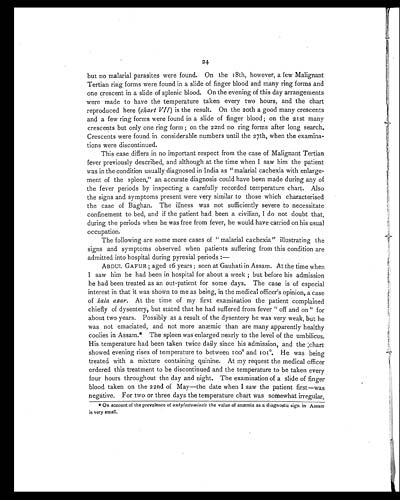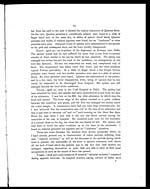Medicine - Institutions > Army health reports and medical documents > Scientific memoirs by officers of the Medical and Sanitary Departments of the Government of India > Number 19 - On kala azar, malaria and malarial cachexia > On kala azar, malaria and malarial cachexia
(32) Page 24
Download files
Individual page:
Thumbnail gallery: Grid view | List view

24
but no malarial parasites were found. On the 18th, however, a few Malignant
Tertian ring forms were found in a slide of finger blood and many ring forms and
one crescent in a slide of splenic blood. On the evening of this day arrangements
were made to have the temperature taken every two hours, and the chart
reproduced here (chart VII) is the result. On the 20th a good many crescents
and a few ring forms were found in a slide of finger blood; on the 21st many
crescents but only one ring form; on the 22nd no ring forms after long search.
Crescents were found in considerable numbers until the 27th, when the examina-
tions were discontinued.
This case differs in no important respect from the case of Malignant Tertian
fever previously described, and although at the time when I saw him the patient
was in the condition usually diagnosed in India as "malarial cachexia with enlarge-
ment of the spleen," an accurate diagnosis could have been made during any of
the fever periods by inspecting a carefully recorded temperature chart. Also
the signs and symptoms present were very similar to those which characterised
the case of Baghan. The illness was not sufficiently severe to necessitate
confinement to bed, and if the patient had been a civilian, I do not doubt that,
during the periods when he was free from fever, he would have carried on his usual
occupation.
The following are some more cases of "malarial cachexia" illustrating the
signs and symptoms observed when patients suffering from this condition are
admitted into hospital during pyrexial periods :—
ABDUL GAFUR; aged 16 years; seen at Gauhati in Assam. At the time when
I saw him he had been in hospital for about a week; but before his admission
he had been treated as an out-patient for some days. The case is of especial
interest in that it was shown to me as being, in the medical officer's opinion, a case
of kala azar. At the time of my first examination the patient complained
chiefly of dysentery, but stated that he had suffered from fever "off and on" for
about two years. Possibly as a result of the dysentery he was very weak, but he
was not emaciated, and not more anæmic than are many apparently healthy
coolies in Assam.* The spleen was enlarged nearly to the level of the umbilicus.
His temperature had been taken twice daily since his admission, and the chart
showed evening rises of temperature to between 100° and 101°. He was being
treated with a mixture containing quinine. At my request the medical officer
ordered this treatment to be discontinued and the temperature to be taken every
four hours throughout the day and night. The examination of a slide of finger
blood taken on the 22nd of May—the date when I saw the patient first—was
negative. For two or three days the temperature chart was somewhat irregular,
* On account of the prevalence of ankylostomiasis the value of anæmia as a diagnostic sign in Assam
is very small.
Set display mode to: Large image | Zoom image | Transcription
Images and transcriptions on this page, including medium image downloads, may be used under the Creative Commons Attribution 4.0 International Licence unless otherwise stated. ![]()
| Permanent URL | https://digital.nls.uk/75027569 |
|---|
| Shelfmark | IP/QB.10 |
|---|---|
| Additional NLS resources: | |




